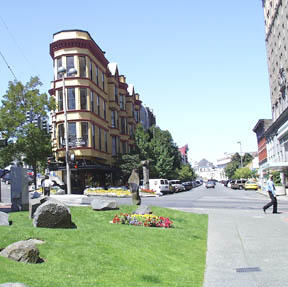The Tacoma City Council heard from the Tacoma Economic Development Department about design concepts and guidelines for Streetscape during Tuesdays study session, as part of a study that assessed the project and made recommendations for implementing it.
Designated by the City Council as one of its top priorities, Streetscape – which involves trees, lighting, artwork, benches, signage and the like that give downtown a sense of place – is a component of Destination Downtown, a public-private alliance to promote Tacomas downtown development.
Destination Downtown went into effect Jan. 10, 2000. In addition to streetscape, it also includes housing, marketing and incentives, development and uses, design guidelines, historic preservation, parks and open spaces, and mobility and parking.
Theres lots of work to be done in this arena, said Juli Wilkerson, Tacoma Economic Development director.
Streetscape plans are in part based on comments that came out of two public workshops – one held in December 2002 and the other in January 2003.
We really appreciated the input we got from the business community, said Peter Huffman, manager of the growth management division of the Tacoma Economic Development Department. They were well attended workshops and we got a lot of feedback.
According to comments from the workshops, Streetscape should:
– distinguish between special districts/ areas;
– be used to entice development;
– be tied to adjacent uses;
– create a sense of uniformity;
– take note of the fact that east/west streets are different;
– take into account the importance of Yakima Avenue; and
– maintain on-street parking.
Toward that end, Streetscape has divided the downtown area based on various street classifications, including signature (Pacific, Tacoma and Yakima avenues) core commercial (A St., Broadway and South 9th and South 11th streets) connector (South 13th, South 15th and South 21st streets) residential and warehouse.
Streetscape looks at individual streets and their main function and prescribes the level of improvement needed, Huffman explained.
This is not really a rocket science classification system, he said. Its a general classification of streets.
Plans call for various street elements – artwork, trees, lights, furniture, special paving and signage – to be used to improve streets based on their function.
Certain areas with special focal features, designated as triangles, gateways and activity nodes, have been given high priority for specialized landscaping, street furniture and signage.
The Streetscape study recommends piggy-backing on the many public and private sector projects under construction in Tacoma, an incremental infilling of trees/landscaping and setting up funds or programs, and comprehensive reconstruction on Pacific and Tacoma avenues.
Short term implementation includes coordinating with major projects and partnering with local agencies to fix up small things such as brackets, furniture, signage and pavement.
Long term recommendations include developing a blanket funding strategy, initiating an arborist program and developing separate master plans for Pacific and Tacoma avenues.
There arent enough resources to do the entire downtown… Huffman explained. So this is prioritizing.
On Aug. 5, the City Council will vote on accepting the study and further implementing its recommendations.
Future steps include incorporating it into code review and revisions and coordinating with retail recruitment and retention efforts.
This project is furthering the goals of Destination Downtown, Huffman said.





